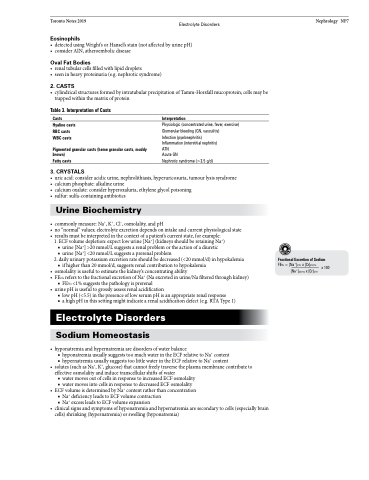Page 707 - TNFlipTest
P. 707
Toronto Notes 2019 Electrolyte Disorders
Eosinophils
• detectedusingWright’sorHansel’sstain(notaffectedbyurinepH) • considerAIN,atheroembolicdisease
Oval Fat Bodies
• renaltubularcellsfilledwithlipiddroplets
• seeninheavyproteinuria(e.g.nephroticsyndrome)
2 . CASTS
• cylindricalstructuresformedbyintratubularprecipitationofTamm-Horsfallmucoprotein;cellsmaybe trapped within the matrix of protein
Nephrology NP7
Table 3. Interpretation of Casts
Casts Hyaline casts RBC casts WBC casts
Pigmented granular casts (heme granular casts, muddy brown)
Fatty casts
3 . CRYSTALS
Interpretation
Physiologic (concentrated urine, fever, exercise) Glomerular bleeding (GN, vasculitis)
Infection (pyelonephritis) Inflammation (interstitial nephritis) ATN
Acute GN
Nephrotic syndrome (>3.5 g/d)
• uricacid:consideracidicurine,nephrolithiasis,hyperuricosuria,tumourlysissyndrome • calciumphosphate:alkalineurine
• calciumoxalate:considerhyperoxaluria,ethyleneglycolpoisoning
• sulfur:sulfa-containingantibiotics
Urine Biochemistry
• commonlymeasure:Na+,K+,Cl–,osmolality,andpH
• no“normal”values;electrolyteexcretiondependsonintakeandcurrentphysiologicalstate • resultsmustbeinterpretedinthecontextofapatient’scurrentstate,forexample:
1. ECF volume depletion: expect low urine [Na+] (kidneys should be retaining Na+) ■ urine [Na+] >20 mmol/L suggests a renal problem or the action of a diuretic
■ urine [Na+] <20 mmol/L suggests a prerenal problem
2. daily urinary potassium excretion rate should be decreased (<20 mmol/d) in hypokalemia ■ if higher than 20 mmol/d, suggests renal contribution to hypokalemia
• osmolality is useful to estimate the kidney’s concentrating ability
• FENa refers to the fractional excretion of Na+ (Na excreted in urine/Na filtered through kidney)
■ FENa <1% suggests the pathology is prerenal
• urinepHisusefultogrosslyassessrenalacidification
■ low pH (<5.5) in the presence of low serum pH is an appropriate renal response
■ a high pH in this setting might indicate a renal acidification defect (e.g. RTA Type 1)
Electrolyte Disorders
Sodium Homeostasis
• hyponatremiaandhypernatremiaaredisordersofwaterbalance
■ hyponatremia usually suggests too much water in the ECF relative to Na+ content ■ hypernatremia usually suggests too little water in the ECF relative to Na+ content
• solutes(suchasNa+,K+,glucose)thatcannotfreelytraversetheplasmamembranecontributeto effective osmolality and induce transcellular shifts of water
■ water moves out of cells in response to increased ECF osmolality
■ water moves into cells in response to decreased ECF osmolality
• ECF volume is determined by Na+ content rather than concentration
■ Na+ deficiency leads to ECF volume contraction
■ Na+ excess leads to ECF volume expansion
• clinicalsignsandsymptomsofhyponatremiaandhypernatremiaaresecondarytocells(especiallybrain
cells) shrinking (hypernatremia) or swelling (hyponatremia)
Fractional Excretion of Sodium
FENa = [Na+]urine x [Cr]plasma [Na+]plasma x [Cr]urine
x 100


